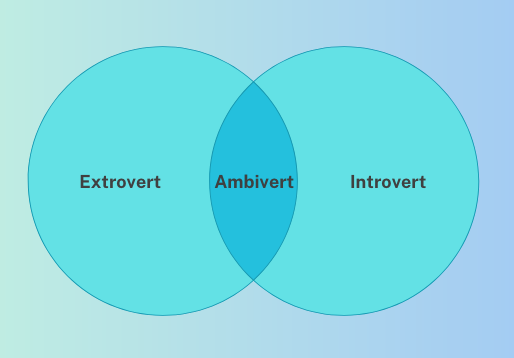Do you crave centre stage whenever you’re with your friends? Do you feel like the life of the party, or like you could talk all night? Or, are you more likely to feel drained by social interactions and need quiet time to recharge? Are you less likely to say yes when invited to large events, preferring instead more one on one scenarios where you don’t have to exert so much energy? Or… maybe you fall somewhere in between?
While I wouldn’t pull out your trusty scientific method just yet, when it comes to personality traits, terms like Extrovert and Introvert have been tossed around for a long time, and although the third term has been around quite a while, it is only in somewhat recent years the internet has given us a third option — the Ambivert, someone who is a little extro- and a little intro- all wrapped into one.
Oxford Languages defines these terms thusly:
ex·tro·vert (noun)
1. an outgoing, overtly expressive person.
in·tro·vert (noun)
1. a shy, reticent person.
am·bi·vert (noun)
1. a person whose personality has a balance of extrovert and introvert features.


There are plenty of articles on the internet to help you figure out which camp you fall into. Most people are likely to fall into one of the binaries, extrovert or introvert, it’s just the way humans work, some are “overtly expressive” and some are “shy”. But figuring out you’re an Ambivert is a little tricky — and yet oh so rewarding once you do. Some estimates put the ambivert camp at 20% of the population or less. This is not an even1/3 divide. This makes it a little rare and a lot special!
We all have a little of the other trait in us — an extrovert who needs a little quiet time, or an introvert who loves a little attention now and again, none of us being quite 100% of either, but it is usually clear to all who know us which trait we exhibit primarily. When our friends can’t quite peg which personality trait we follow, when being either intro- or extro- is a little bit of a surprise each time, then we might fall in the ambi- category.
Ambi- comes from Latin, it means “on both sides” and this is a wonderful descriptor. If you draw a Venn Diagram of these terms, it will come out looking something like this:

Where they overlap, you get Ambivert, straddling both side of the equation.
It isn’t that you aren’t social, if you’re an ambi-, it just means there are limits to your comfort in these situations. You can be reserved sometimes, and enjoy being in a crowd other times. One thing an Ambivert does really well is cultivate good relationships — you like to have others around who not only can relate to your feelings, but who can support you in social scenarios when you’re feeling more intro-. You might find, when you take an online quiz to determine your personality trait, it depends on the mood of the moment whether the quiz will tell you that you are Introverted or Extroverted. This is normal for Ambiverts — it is rarely divided straight down the middle. In fact, the Venn Diagram above is maybe too perfectly drawn, it would be more realistic if the circle was leaning a little one way or the other.
Being able to do this balancing act means that ambi-’s are very truly adaptable to most situations. You tend to be a good conversationalist, being comfortable speaking and also able to actively listen to those you are engaged with — this makes others want to talk more with you, and often puts them at ease. Being able to connect with others from both sides of the spectrum comes naturally because you can easily empathize with both introverts and extroverts. And Ambiverts tend to be a little more in tune with their own needs, taking downtime seriously and asking for what they need in the moment.
All this being what it is, Ambiverts aren’t some magical human who has their act together all the time. Ambi-’s are just that, human, and thusly fallible. But when it comes to personality traits, having a little bit of both sides tends to give one a sense of balance that others often strive for — being the belle of the ball all the time is exhausting and sometimes alienating, and shying away from the ball altogether is both isolating and can lead to worse things, like depression. Balance is key in how we interact with the world. So taking our cues from the on-both-sides camp can maybe help those who teeter too far in either direction. We can’t all be Ambiverts, if that’s not already our personality trait, but we can all learn some new tricks of the trait!
If you’re struggling with any of these traits and looking for more balance in your life, reach out and let’s talk!
